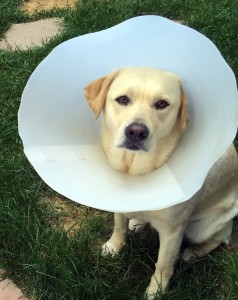
The summer season is here with warm weather and sometimes very muggy days. For Miya, who is a yellow Labrador Retriever with very think dense fur this time of the year takes a toll on her in many ways. Luckily she loves to swim in lakes, ponds and our backyard pool to cool off. However if you don’t dry your dog off after those swims, they can begin the process of developing a Hot Spot. In Miya’s case we have a towel ready to dry her off but sometimes she still gets a Hot Spot, which is very itchy and uncomfortable for her.
Last summer Miya got a Hot Spot which became so red and raw we needed to take more invasive action by having her fur shaved and getting her on antibiotics. The site of where the Hot Spot was very ugly and red looking and Miya was very uncomfortable. This year we are hoping to help control this for her, by arming ourselves with more information to help her.
What is a Hot Spot (Also known as Summer Sores or Moist Eczema)?
Hot Spots, Summer Sores or Moist Eczema are skin irritations which are more prevalent in the summer months. These spots can appears anywhere on a dog’s body. They can cause severe itching which in turn leads the dog to itch, scratch or lick herself or himself excessively, eventually forming a wet scab on the fur that leads to the infection going deep into the layers of the skin. This is why hot spots could take up to two weeks to finally look like they are going to heal. If your dog has extensive and deep sore areas, your veterinarian will prescribe oral and/or topical antibiotics and antihistamines and large areas of your dog’s skin will need to be shaved.
How to help prevent Hot Spots
Keeping your dog’s skin healthy is the key to help preventing hot spots! Make sure your dog is free of fleas and ticks. If your dog, like Miya, or German Shepherds which have very thick, heavy coats, you need to brush her regularly. If your dog has a long, thick coat like a Collie or Golden Retriever you need to get them groomed regularly to prevent their coat from matting. Matted fur traps moisture and parasites, such as fleas, creating the ideal environment for hot spots. Finally, when your dog gets wet or muddy, rinse and towel dry them off as quickly as possible. We also found that by leaving a wet collar on Miya was not a wise thing to do. The collar expedited her getting a Hot Spot on her neck just where the collar sat.
Summary
In the end if your dog still develops or you suspect your dog is developing a Hot Spot contact your veterinarian. Your vet will trim the area to expose the wound to the air and begin a course of antibiotics. Exposing the wound will dry out the moisture and help speed the healing.
Here’s to a Hot Spot-less summer!
However in the end it may very well still happen. If your dog has had a Hot Spot in past summers, please leave your comments and some of things you have tried for your dogs. We would love to hear about them.



